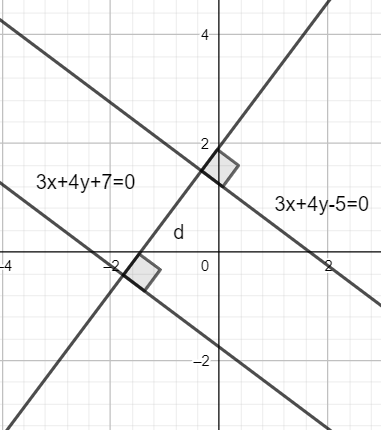
What is the distance between the parallel lines 3x + 4y + 7 = 0 and 3x + 4y – 5 = 0?
(a). \[\dfrac{2}{5}\]
(b). \[\dfrac{{12}}{5}\]
(c). \[\dfrac{5}{{12}}\]
(d). \[\dfrac{3}{5}\]
Answer
601.5k+ views
Hint: The distance between two parallel lines \[ax + by + {c_1} = 0\] and \[ax + by + {c_2} = 0\] is given by the formula \[d = \dfrac{{|{c_1} - {c_2}|}}{{\sqrt {{a^2} + {b^2}} }}\]. Use this formula to find the distance between the given lines.
Complete step-by-step answer:
Two lines are said to be parallel if they do not intersect at any finite point in the space. They always maintain the same distance between them.
The equations of the parallel lines have the x and y coefficient as proportional to each other.
For finding the distance between the two parallel lines, we first express the two equations such that the coefficients of x and y are equal.
We have the equations of two lines as follows:
3x + 4y +7 = 0
3x + 4y – 5 = 0
Hence, we have both equations such that the x and y coefficients are equal.

Now, we use the formula for calculating the distance between two parallel lines \[ax + by + {c_1} = 0\] and \[ax + by + {c_2} = 0\] given as follows:
\[d = \dfrac{{|{c_1} - {c_2}|}}{{\sqrt {{a^2} + {b^2}} }}\]
From the equations of the lines, we have:
\[{c_1} = 7\]
\[{c_2} = - 5\]
a = 3
b = 4
Then, we have:
\[d = \dfrac{{|7 - ( - 5)|}}{{\sqrt {{3^2} + {4^2}} }}\]
Simplifying, we have:
\[d = \dfrac{{|7 + 5|}}{{\sqrt {9 + 16} }}\]
\[d = \dfrac{{|12|}}{{\sqrt {25} }}\]
We know that the square root of 25 is 5. Hence, we have:
\[d = \dfrac{{12}}{5}\]
Hence, the correct answer is option (b).
Note: Note that you should take care of the negative sign in the equation 3x + 4y – 5 = 0 and include it while calculating the distance, otherwise, your answer will be \[\dfrac{2}{5}\], option (a), which is wrong.
Complete step-by-step answer:
Two lines are said to be parallel if they do not intersect at any finite point in the space. They always maintain the same distance between them.
The equations of the parallel lines have the x and y coefficient as proportional to each other.
For finding the distance between the two parallel lines, we first express the two equations such that the coefficients of x and y are equal.
We have the equations of two lines as follows:
3x + 4y +7 = 0
3x + 4y – 5 = 0
Hence, we have both equations such that the x and y coefficients are equal.

Now, we use the formula for calculating the distance between two parallel lines \[ax + by + {c_1} = 0\] and \[ax + by + {c_2} = 0\] given as follows:
\[d = \dfrac{{|{c_1} - {c_2}|}}{{\sqrt {{a^2} + {b^2}} }}\]
From the equations of the lines, we have:
\[{c_1} = 7\]
\[{c_2} = - 5\]
a = 3
b = 4
Then, we have:
\[d = \dfrac{{|7 - ( - 5)|}}{{\sqrt {{3^2} + {4^2}} }}\]
Simplifying, we have:
\[d = \dfrac{{|7 + 5|}}{{\sqrt {9 + 16} }}\]
\[d = \dfrac{{|12|}}{{\sqrt {25} }}\]
We know that the square root of 25 is 5. Hence, we have:
\[d = \dfrac{{12}}{5}\]
Hence, the correct answer is option (b).
Note: Note that you should take care of the negative sign in the equation 3x + 4y – 5 = 0 and include it while calculating the distance, otherwise, your answer will be \[\dfrac{2}{5}\], option (a), which is wrong.
Recently Updated Pages
Master Class 12 English: Engaging Questions & Answers for Success

Master Class 12 Business Studies: Engaging Questions & Answers for Success

Master Class 12 Economics: Engaging Questions & Answers for Success

Master Class 12 Social Science: Engaging Questions & Answers for Success

Master Class 12 Maths: Engaging Questions & Answers for Success

Master Class 12 Chemistry: Engaging Questions & Answers for Success

Trending doubts
What are the major means of transport Explain each class 12 social science CBSE

Which are the Top 10 Largest Countries of the World?

Draw a labelled sketch of the human eye class 12 physics CBSE

Explain sex determination in humans with line diag class 12 biology CBSE

The pH of the pancreatic juice is A 64 B 86 C 120 D class 12 biology CBSE

Explain sex determination in humans with the help of class 12 biology CBSE




